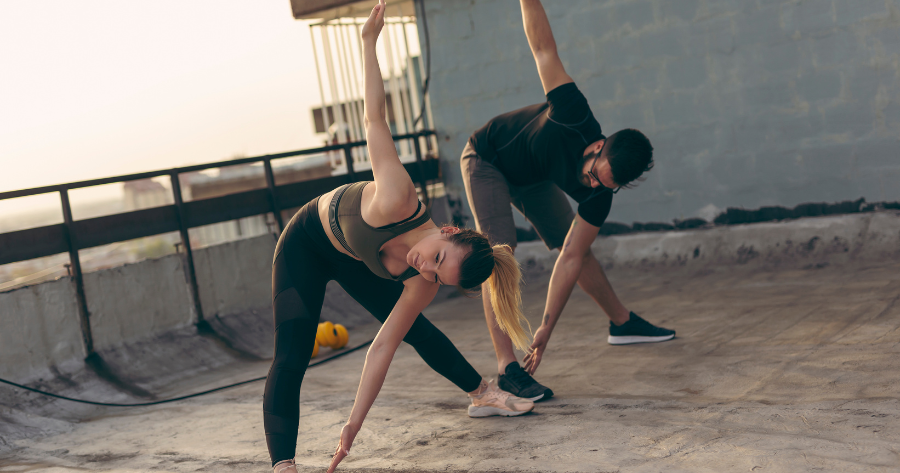Stretching is often overlooked, but it is crucial in optimizing your workout routine. Whether you’re a seasoned athlete or a beginner, incorporating stretching into your exercise regimen can benefit your body and overall fitness. This article will explore why stretching is essential and how it improves muscle health, enhances workout performance, and prevents injuries. We will also discuss different stretching techniques and offer practical tips on integrating stretching into your daily exercise routine.
The Importance of Stretching for Muscle Health
Your muscles are your body’s powerhouse, enabling you to move, lift, and perform physical activities. Neglecting their care can lead to stiffness, reduced flexibility, and increased risk of injuries. That’s where stretching comes into the picture. When you stretch, you increase the blood flow to your muscles, which helps deliver oxygen and nutrients while removing waste products. This improved circulation promotes muscle growth and repair, ultimately enhancing muscle health.
Stretching also helps lengthen and relax your muscles, reducing muscle tension and soreness from intense workouts. It increases your range of motion and flexibility, making daily activities easier and preventing muscle imbalances that may lead to pain or dysfunction. By incorporating regular stretching into your workout routine, you can maintain optimal muscle health, allowing you to push your limits and achieve better results.
But did you know that stretching offers even more benefits beyond muscle health? It can also improve your overall posture. Many people spend hours sitting at desks or hunched over electronic devices, which can lead to poor posture and chronic pain. Stretching, particularly exercises that target the muscles in your back and shoulders, can help alleviate these issues. By stretching regularly, you can lengthen tight muscles and strengthen weak ones, promoting a more balanced and upright posture.
In addition to improving posture, stretching can also enhance athletic performance. When your muscles are properly stretched, they are more prepared for the demands of physical activity. This means you can move more efficiently, with greater power and agility. Whether you are a professional athlete or a weekend warrior, adding stretching to your training routine can give you that extra edge and help you reach your performance goals.
The Benefits of Dynamic Stretching
Dynamic stretching involves moving parts of your body through a full range of motion. It is particularly beneficial before a workout as it helps warm your muscles, increases blood flow, and prepares your body for future movements. Dynamic stretches often mimic your actions during your exercise routine, creating a seamless transition and reducing the risk of injury. Examples of dynamic stretches include arm circles, walking lunges, and leg swings.
The Benefits of Static Stretching
On the other hand, static stretching involves holding a stretch position for an extended period without any movement. While static stretches are better suited for post-workout cool-downs, they can also be beneficial when performed correctly. Static stretching helps improve flexibility, relax muscles, and reduce muscle soreness after intense physical activity. Common static stretches include hamstring, quadricep, and calf stretches.
So, whether you want to improve your muscle health, enhance your posture, or boost your athletic performance, stretching is essential to any fitness routine. Make sure to incorporate dynamic and static stretches into your workouts to reap the maximum benefits. Remember, taking care of your muscles today will pay off in the long run, allowing you to lead a healthier, more active lifestyle.

How Stretching Enhances Your Workout Performance
Stretching isn’t just about preventing injuries and improving muscle health. It can also significantly impact your overall workout performance. When you properly stretch your muscles before exercising, you increase their elasticity and range of motion. This means you can move more freely and with less effort, allowing you to perform exercises with proper form and technique.
Furthermore, stretching promotes better muscle coordination and balance, which are essential for executing complex movements effectively. By enhancing your body’s ability to move efficiently, stretching can significantly improve your athletic performance and help you reach your fitness goals more effectively.
Stretching can also aid in mental preparation before a workout. Taking a few minutes to focus on stretching allows you to calm your mind, improve your concentration, and enter a more focused and energized state. It can be a valuable opportunity to visualize your workout and mentally prepare for the challenges ahead.
Moreover, incorporating dynamic stretching into your warm-up routine can further enhance your workout performance. Dynamic stretching involves moving your muscles and joints through a full range of motion in a controlled manner. This type of stretching increases blood flow, raises your body temperature, and helps improve muscle activation, preparing your body for more intense physical activity.
Additionally, post-workout stretching is crucial for aiding muscle recovery and reducing muscle soreness. Stretching after exercise helps lengthen tight muscles, prevent stiffness, and promote blood circulation to assist in the repair and growth of muscle tissues. It can also help reduce the risk of muscle imbalances and improve overall flexibility, leading to better performance in future workouts.
The Role of Stretching in Injury Prevention
Injuries are not only painful but can also set back your progress and hinder your ability to exercise. Stretching is vital in injury prevention by improving your body’s flexibility and resilience. When your muscles are flexible, they can withstand a wider range of movements without strain or damage. This flexibility reduces the likelihood of muscle pulling or tearing during physical activity.
Additionally, stretching helps to improve joint health and mobility. Maintaining or improving your joint range of motion reduces the risk of joint-related injuries and conditions, such as sprains and strains. Moreover, proper stretching before exercise helps to activate and prepare the relevant muscles, tendons, and ligaments, preventing them from being caught off guard during more intense movements.
Furthermore, incorporating dynamic stretching into your routine can enhance your athletic performance. Dynamic stretching involves moving parts of your body and gradually increasing reach, speed of movement, or both. This type of stretching helps to improve blood flow, warm up your muscles, and enhance your overall agility and coordination, all of which are crucial for optimal performance in various physical activities.
Another benefit of regular stretching is its positive impact on posture. Tight muscles can lead to poor posture, resulting in discomfort and chronic pain over time. Stretching helps to lengthen and relax muscles, promoting better alignment of the body’s musculoskeletal structure.
Maintaining good posture through stretching can reduce the risk of developing musculoskeletal issues and improve your overall physical appearance and confidence.
Integrating Stretching into Your Daily Exercise Regimen
Now that we understand the importance of stretching, let’s explore how you can integrate it into your daily exercise routine. The ideal time to stretch is after a proper warm-up, as it allows your muscles to be more receptive to stretching and less prone to injury. After your workout, you can incorporate static stretches to improve flexibility and promote muscle recovery.
It’s important to note that stretching should never be done forcefully, causing pain or making you uncomfortable. Instead, focus on gentle and controlled movements, gradually increasing the intensity and duration as your body becomes more flexible. Remember to breathe deeply and relax while stretching, allowing your mind and body to connect and feel calm.
If you’re unsure about specific stretches or techniques, consider consulting a professional, such as a personal trainer or physical therapist. They can provide guidance tailored to your fitness level, goals, and any pre-existing conditions or injuries you may have.
Incorporating stretching into your exercise routine may seem like an additional task, but its benefits are well worth the effort. By stretching, you can improve your muscle health, enhance your workout performance, prevent injuries, and optimize your overall fitness journey. So, prioritize stretching and reap the rewards of a well-rounded, injury-free workout routine!
Dynamic Stretching
Now, let’s delve deeper into the different stretching techniques you can incorporate into your daily exercise regimen. One popular method is dynamic stretching, which involves moving your joints and muscles through a full range of motion. This type of stretching is particularly beneficial before a workout as it helps to increase blood flow, warm up the muscles, and improve overall mobility.
PNF Stretching
Another effective stretching technique is proprioceptive neuromuscular facilitation (PNF) stretching. This method involves a combination of stretching and contracting muscles to improve flexibility. PNF stretching is often performed with a partner or with the assistance of a resistance band, allowing for a deeper stretch and increased muscle activation.

Yoga
In addition to these techniques, you can also explore the world of yoga, which offers a wide range of stretching poses and flows. Yoga not only helps to improve flexibility but also promotes balance, strength, and mindfulness. Whether you prefer a gentle restorative yoga practice or a more vigorous vinyasa flow, incorporating yoga into your exercise routine can benefit your body and mind.
Remember, stretching is not just reserved for the gym or workout sessions. You can also incorporate stretching into your daily activities. Take a few moments to stretch when you wake up in the morning, during your lunch break, or before bed. These small stretches throughout the day can help to relieve tension, improve posture, and increase overall well-being.
So, as you embark on your fitness journey, don’t forget to prioritize stretching. Incorporating different stretching techniques into your daily exercise regimen can enhance your performance, prevent injuries, and achieve optimal physical and mental well-being.
Start today and experience the transformative power of stretching! If you want to learn more about maintaining peak athletic performance – talk to the experts at Nobility Chiropractic today.


